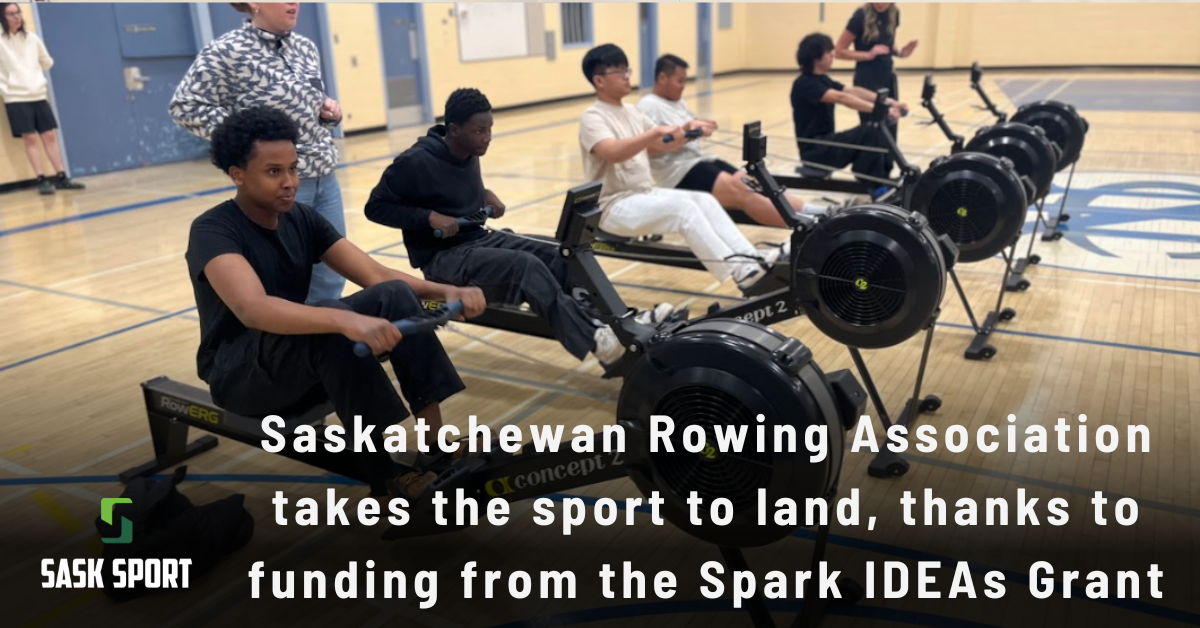Water sports deal with their own set of limitations due to the structure of their event taking place strictly on water, which is not always an accessible resource.
Saskatchewan Rowing Association had an idea to adapt their on-water sport and create an accessible program within community schools to address the otherwise limited exposure often seen in rowing.
With funding from the Spark IDEAs Grant, provided through the Sask Lotteries Trust Fund, their vision came to life.
The grant’s purpose is to increase Inclusive, Diverse, Equitable, and Accessible opportunities in Saskatchewan’s amateur sport system, while achieving lasting change. With the aid of member-led initiatives, the grant is designed to expand the accessibility of quality sport in the province.
With the grant’s funding, Saskatchewan Rowing was able to purchase ten rowing machines and connect with community schools in Saskatoon that were interested in introducing the program to students. In addition, Amy Shipley with the Spark IDEAs Grant worked closely with Saskatchewan Rowing to help with the logistics of getting the program organized.
“Our goal was to try and bring indoor rowing and eventually on-water rowing to youth that are traditionally not in our sport, at least not in Saskatchewan,” said Nicole Golden, the Executive Director & Development Officer with Saskatchewan Rowing. “Indigenous and Newcomer youth were our focus, [as we worked] to expose them to the sport and let them see the fun of it, the health of it, the teamwork of it; through a very safe and accessible program.”
Offered to students Grade 5 and up, the program has partnered with Westmount Community School, King George School, St. Francis Cree School and Nutana Collegiate, with a goal of continued expansion in the future.
In the program’s first year, Saskatchewan Rowing witnessed varying levels of success from the beginning.
“All of [our partnering schools] have high populations of Indigenous and Newcomer youth, so the majority of the youth who participated in the program were from those backgrounds. We were so pleased to be able to have them involved and see how it emboldened their spirit,” said Golden.
More than 500 students have had the opportunity to explore indoor rowing during test days, held in each participating school. Conducted over multiple 45-minute sessions, classes were brought in to test the rowing machines and have an opportunity to speak with coaches in attendance.
According to Golden, the students who joined the four-to-six-week program remained engaged throughout and challenged their abilities.

“On day one, the kids could only row for a minute at a time, by the final day the kids competed in a one-kilometre race on the indoor rowing machine, which is eight-to-ten minutes of steady rowing,” said Golden.
The value of the program is seen in more than just physical well-being, as it offers rowing as an option to a more diverse community, who otherwise may not have access to the sport.
“As a sport, as a Provincial Sport Organization, we recognize that our sport has not represented our population well and so if we are going to say that we are interested in being representative, we have to take really direct focus to engage those individuals,” said Golden.
In an effort to take active steps toward achieving their goal of offering a more accessible version of their sport to a more diverse community, Saskatchewan Rowing welcomed anyone who was interested.
That included Muscowpetung First Nation, located north-east of Regina. It was the first program to take place outside of Saskatoon, with 60-80 students from the Muscowpetung First Nation coming out to explore indoor rowing, over a two-day period.
And this is only the beginning.
While the program is currently only offered (due to the limited location of rowing clubs in the province) out of Saskatoon and will include Regina in the future; Saskatchewan Rowing hopes to continue expanding the program to more schools and communities, growing the number of active participants in local clubs. Golden encourages communities to bring interested individuals to on-water training or reach out to discuss options of hosting the program.
“It’s one thing for us to put it in a strategic plan that we would like to have more representation in our sport…for us we have to take tangible live steps to make that engagement happen.”
